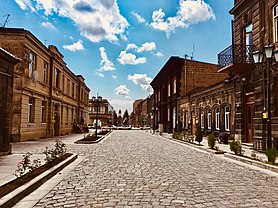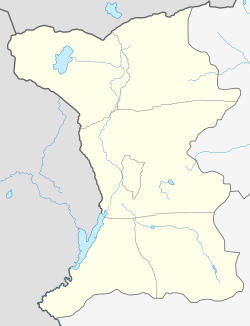
Back Gjoemri Afrikaans غيومري Arabic جيومرى ARZ Guiumri AST Комур AV Gümrü Azerbaijani گیومری AZB Гюмры Byelorussian Гюмры BE-X-OLD Гюмри Bulgarian
Gyumri
Գյումրի | |
|---|---|
City and urban community | |
From top down, left to right; Abovyan street view • City Hall • Cathedral of Gyumri • Dzitoghtsyan Museum of National Architecture • Independence Square • Gyumri skyline | |
| Nickname: Hayrakaghak ("Father-city") | |
| Coordinates: 40°47′22″N 43°50′51″E / 40.78944°N 43.84750°E | |
| Country | Armenia |
| Province | Shirak |
| Founded as Kumayri by the Urartians | 8th century BC |
| Rebuilt as Alexandropol by Nicholas I of Russia | 1837 |
| Government | |
| • Type | Mayor–council |
| • Mayor | Samvel Balasanyan |
| Area | |
• Total | 54 km2 (21 sq mi) |
| Elevation | 1,509 m (4,951 ft) |
| Population (2022 census) | |
• Total | 112,301[1] |
| Demonym | Gyumretsi |
| Time zone | UTC+4 (AMT) |
| Postal code | 3101-3126 |
| Area code | (+374) 312 |
| Vehicle registration | 45 am |
| Climate | Dfb |
| Website | www |
| Sources: Population[2] | |
Gyumri (Armenian: Գյումրի,[a] pronounced [ɡjumˈɾi]) is an urban municipal community and the second-largest city in Armenia, serving as the administrative center of Shirak Province in the northwestern part of the country. By the end of the 19th century, when the city was known as Alexandropol,[b] it became the largest city of Russian-ruled Eastern Armenia with a population above that of Yerevan. The city became renowned as a cultural hub, while also carrying significance as a major center of Russian troops during Russo-Turkish wars of the 19th century.
The city underwent a tumultuous period during and after World War I. While Russian forces withdrew from the South Caucasus due to the October Revolution, the city became host to large numbers of Armenian refugees fleeing the Armenian genocide, in particular hosting 22,000 orphaned children in around 170 orphanage buildings. It was renamed Leninakan[c] during the Soviet period and became a major industrial and textile center in Soviet Armenia.[3] The city's population rapidly grew to above 200,000 prior to the 1988 Spitak earthquake, when it was devastated, with the city's population being reduced to 121,976 as of the 2011 census. The city was renamed Gyumri under modern independent Armenia soon after the breakup of the Soviet Union, and post-earthquake reconstruction efforts continue. As of the 2022 census, the population of the city was 112,301.[1]
Today, Gyumri continues to grapple with the lasting effects of the 1988 earthquake, but remains known as the cultural hub of Armenia due to the many artists and craftsman who originated from the city. The city is also in particular notable for the large Kumayri historic district that managed to mostly survive the 1988 earthquake, dating back mainly to the 19th century and being one of the few surviving places in the world with authentic urban Armenian architecture.[3]
- ^ a b "The Main Results of RA Census 2022, trilingual / Armenian Statistical Service of Republic of Armenia". www.armstat.am. Retrieved 2024-11-08.
- ^ "Armstats : Population" (PDF). Armstat.am. Retrieved 15 December 2014.
- ^ a b "History". Visit Gyumri. Archived from the original on 2019-01-07. Retrieved 2022-07-18.
Cite error: There are <ref group=lower-alpha> tags or {{efn}} templates on this page, but the references will not show without a {{reflist|group=lower-alpha}} template or {{notelist}} template (see the help page).









